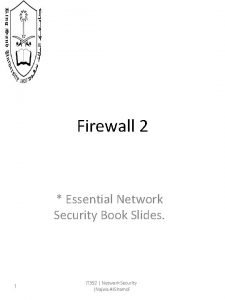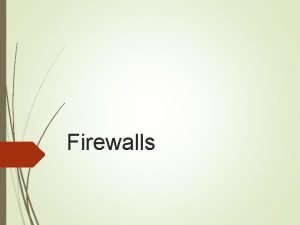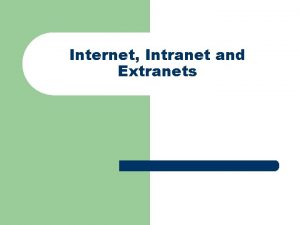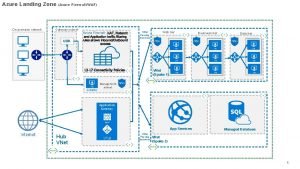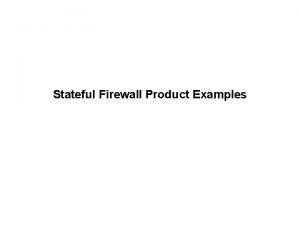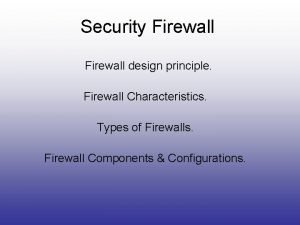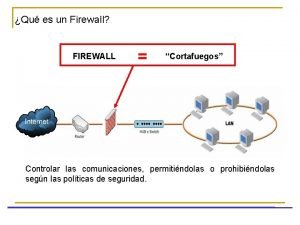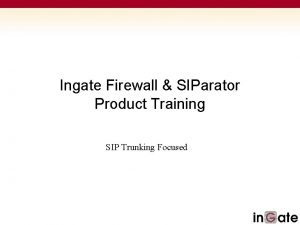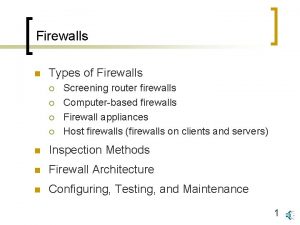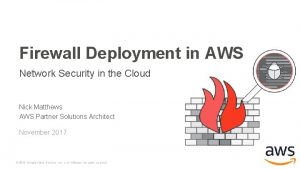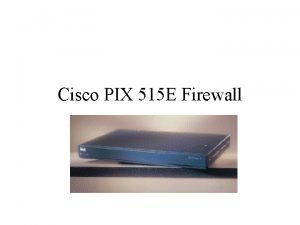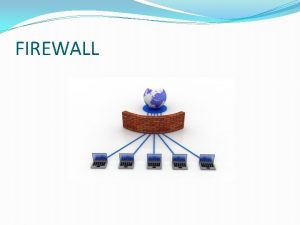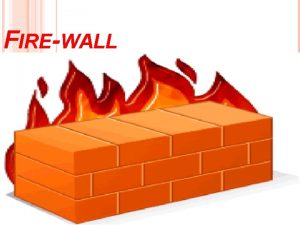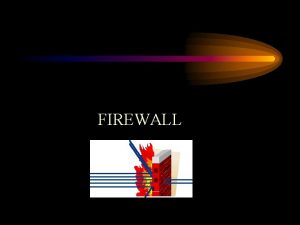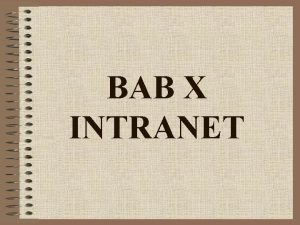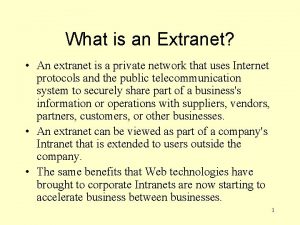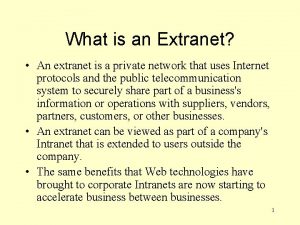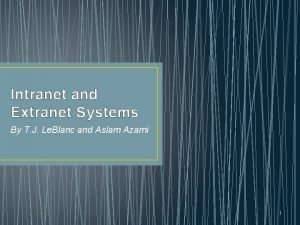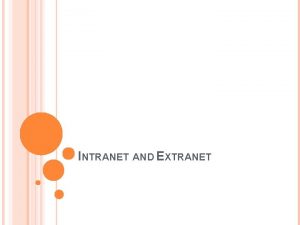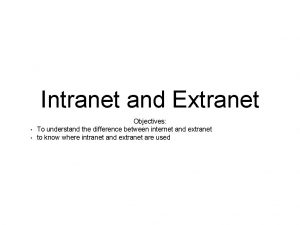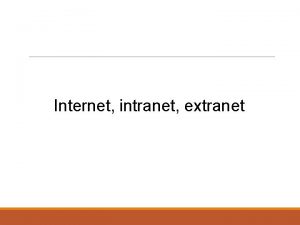Intranet Extranet Firewall Intranet and Extranet What is































- Slides: 31

Intranet, Extranet, Firewall

Intranet and Extranet

What is Intranet �Definition: �An Intranet is a private computer network that uses Internet protocols, network connectivity, and possibly the public telecommunication system to securely share part of an organization’s information or operations with its employee.

�Basically �It uses the same concepts and technologies of the internet (clients and servers) running on the TCP/IP protocol suite. �HTTP, FTP and SMTP and very commonly used. �Access to information is typically through browsers. �Platform independent.

�Advantage: �Intranet help employees to quickly locate information and applications relevant to their roles and responsibilities. �Standard interface, allowing “access from anywhere”. �Can serve as a powerful tool for communication within an organization. �Both vertically and horizontally �Permits information to be published.

What is Extranet �Definition �An Extranet is private network that uses internet protocols, network connectivity, and possibly the public communication system to securely share part of an organization’s information or operations with suppliers, partners, customers, or other businesses. �Can be viewed as part of a company’s

�Basically �It is “a private internet over the Internet”. �Used to designate “private parts” of a website. �Only registered users can navigate. �It requires security and privacy. �Firewall server management. �Issuance and use of digital certificates or similar means of authentication. �Encryption of messages. �Use of Virtual Private Network (VPN) that tunnel through the public network.

�Advantages: �Can improve organization productivity. �Allows information to be viewed at times convenient for external users. �Cut down on meeting times. �Information can be updated instantly. �Authorized users have immediate access to latest information �Can improve relationships with customers.

Firewall

Why Firewalls �Firewall are effective to: �Protect local systems. �Protect network-based security threats. �Provide secured and controlled access to Internet �Provide restricted and controlled access from the Internet to local servers.

Firewall Characteristics �Design goals: �All traffic from inside to outside must pass through the firewall. �Only authorized traffic will be allowed to pass. �Defined by local security policy. �The firewall itself is immune to penetration. �Use of trusted system with a secure operating system.

Types of Firewalls 1. Packet filters. 2. Application-level gateways 3. Circuit-level gateways.

Packet Filtering Firewall Private network Internet Packet Filtering router �Some of the attacks that can be made on packet filtering routers: �IP address spooling �Source Routing attacks

Packet Filtering Firewall �Applies a set of rules to each incoming IP packet and then forwards or discards the packet. �Typically based on IP addresses and port numbers. �Filter packets going in both directions. �The packet filter is typically set up as a list of rules based on matches to fields in the IP or TCP header. �Two default policies (discard or forward).

Packet Filtering Firewall � Advantages: � Simplicity � Transparency to users � High speed � Disadvantages: � Difficulty of setting up packet filter rules � Lack of authentication

Application-Level gateway Outside Connection FTP Inside Connection HTTP SMTP Outside Host Application-Level Gateway �Also called a Proxy Server; acts as relay of application level traffic. �It is service specific. Inside Host

Application-level Gateway �Also called proxy server �Acts as a relay of application-level traffic �Advantages: �Higher security than packet filters �Only need to scrutinize a few allowable applications �Easy to log and audit all incoming traffic �Disadvantages: �Additional processing overhead on each connection (gateway as splice point)

Circuit-level gateway Outside Connection Outside Host Ou t In O ut In Inside Connection Inside Host Circuit-level gateway

Circuit-level Gateway �Stand-alone system, or specialized function performed by an Application-level Gateway. �Does not permit end-to-end TCP connection; rather the gateway sets up two TCP connections: �The gateway typically relays TCP segments from one connection to the other without examining the contents. �The security function consists of determining which connections will be allowed.

Bastion Host �It is a system identified by the firewall administrator as a critical point in the network’s security. �It executes a secure version of its OS and is trusted �It consists of services which are essential. �Requires additional authentication before access is allowed

Firewall Configurations �In addition to the use of simple configuration of a single system, more complex configurations are possible. �Three common configurations are in popular use. �Single-homed host. �Dual-homed host �Screened subnet.

Single-homed Host

�Firewall consists of two system: �A packet-filtering router �A bastion host �Configuration for the packet-filtering router: �Only packets from and to the bastion host are allowed to pass through the router. �The bastion host performs authentication and proxy functions.

�Greater security than single configurations because of two reasons: �Implements both packet-level and application-level filtering (allowing for flexibility in defining security policy). �An intruder must generally penetrate two separate systems.

Dual-homed host

�The packet-filtering router is not completely compromised. �Traffic between the Internet and other hosts on the private network has to flow through the bastion host.

Screened Subnet

�Most secure configuration of the three. �Two packet-filtering routers are used. �Creation of an isolated subnetwork.

�Advantages: �Three levels of defense to thwart intruders. �The outside router advertises only the existence of the screened subnet to the Internet. �Internal network is invisible to the Internet. �The inside router advertises only the existence of the screened subnet to the internal network.

Intranet/Extranet Design Issues

�For Intranet: �Analysis of the organization flow. �Identify various cress-sections of employees, and their access privileges. �Enforce authentication mechanism. �For Extranet: �Security is the major concern. �Combination of firewalls, authentication, VPN, etc. must be used.
 What is personal firewall and distributed firewall.
What is personal firewall and distributed firewall. Stateful firewall vs stateless
Stateful firewall vs stateless Intranet and extranet in e commerce
Intranet and extranet in e commerce Difference between internet and intranet
Difference between internet and intranet Internet intranet extranet
Internet intranet extranet Stateful and stateless firewall
Stateful and stateless firewall Inter and trans firewall analytics
Inter and trans firewall analytics Firewall in cryptography and network security
Firewall in cryptography and network security Site:slidetodoc.com
Site:slidetodoc.com Advantages and disadvantages of firewall
Advantages and disadvantages of firewall Firewall evaluation criteria
Firewall evaluation criteria Firewall analysis tool
Firewall analysis tool Utm waf
Utm waf Stateful firewall iptables
Stateful firewall iptables Single homed bastion host
Single homed bastion host Qu firewall
Qu firewall Firewall icon in packet tracer
Firewall icon in packet tracer Commvault firewall ports
Commvault firewall ports A history and survey of network firewalls
A history and survey of network firewalls Mc firewall
Mc firewall Juniper switch icon
Juniper switch icon Bastille linux
Bastille linux Web insight waf
Web insight waf Ingate siparator
Ingate siparator Circuit relay firewall
Circuit relay firewall Ejemplos de firewall
Ejemplos de firewall Komponen sistem firewall
Komponen sistem firewall Aws network firewall multi az
Aws network firewall multi az Router cisco icon
Router cisco icon Topologuy
Topologuy Rv110w emulator
Rv110w emulator Cisco pix 515 firewall
Cisco pix 515 firewall
